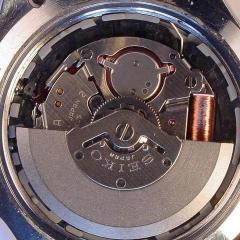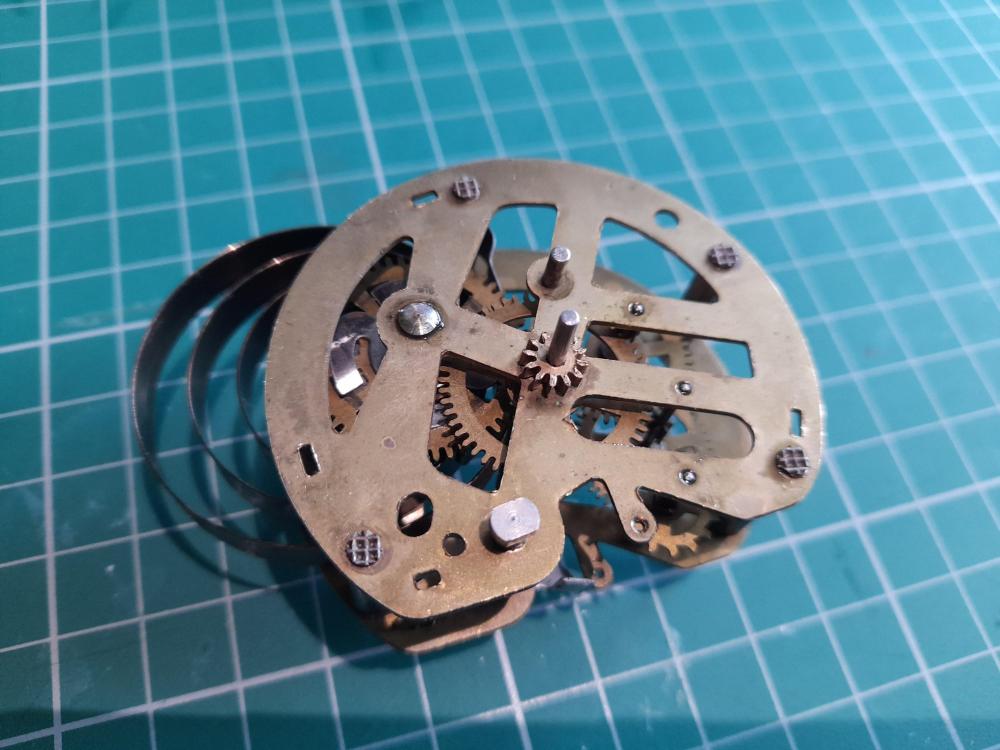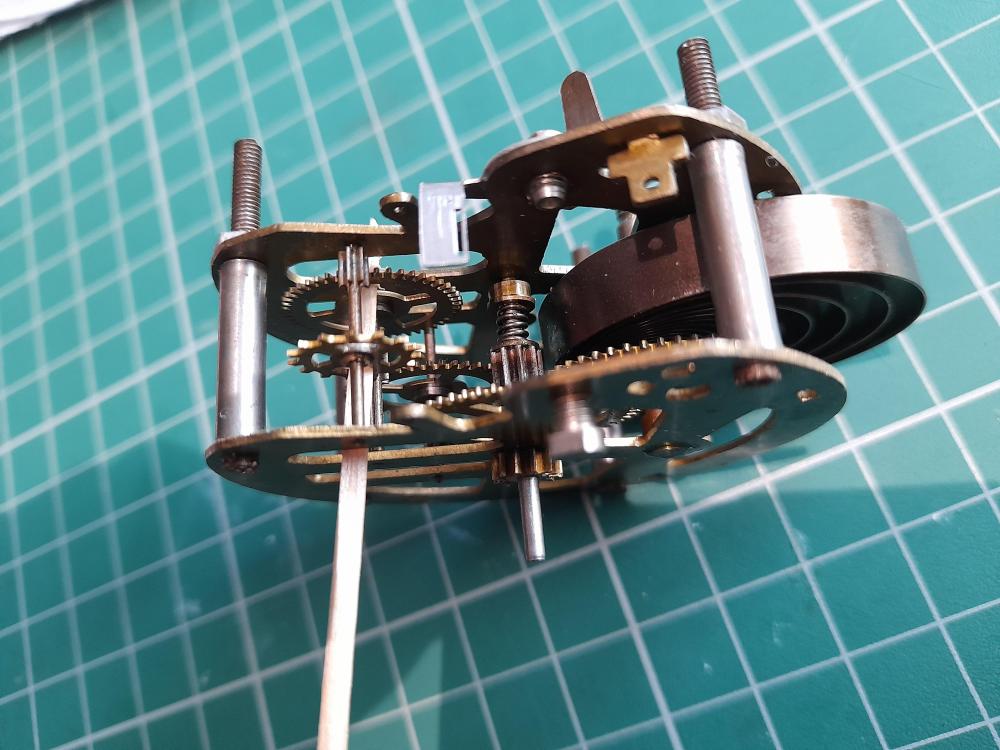Leaderboard
Popular Content
Showing content with the highest reputation on 11/18/21 in Posts
-
May I, too? Imo you are absolutely right. Lift is just a part of what timing machines call a lift angle. This same discussion I had some time ago in a German forum. My suggestion was "Hemmungswinkel" (escapement angle) :-)) Frank3 points
-
Hi The Glashuette 65 uses 53Deg Lift angle so working on the assumption the 60.1 is of the same family its probably the same. hope its useful if not I will shut up.2 points
-
The timing machine picks up three sounds, when the impulse jewel hits the fork, when fork unlocks and an escape tooth hits the impulse surface of a pallet jewel, and when the next tooth locks on the other pallet jewel. These are the three spikes you see on oscilloscope readings of the escapement. The lift angle is the angle the balance goes through from the moment the impulse jewel contacts the fork slot to the moment it ceases to be in contact.2 points
-
I do not know, but you can calculate the lift angle yourself by winding the watch slowly until the balance reaches 180 degrees amplitude, then finding the lift angle on your timegrapher that gives a reading of 180 degrees.2 points
-
No Matter what the size of a spring is the damage it can do can be substantial . I did an omega watch that broke the spring and it ripped three teeth off the 4th wheel and I have had barrel teeth ripped off on some clocks and pivots broken off. So whenever working on any spring powered appliance ALWAYS remove the power before the spring removes a finger. Old Hippys method is tried and tested as is clockboys, what ever the method safety first. Good luck with the clock.2 points
-
That little pinion just pulls off but it is a tight fit as it provides the friction coupling between the going train and the motion works that would normally be accomplished by the canon pinion. In fact it is sometimes referred to as an off set canon pinion.1 point
-
@praezis Ya this is also what Daniels calls the sum of the unlocking and impulse angles. Glad we had the same thought. Thanks @nickelsilver1 point
-
1 point
-
Hey, JDM! Welcome to the basement! Snacks are over by the water cooler. If you kill the coffee pot, you fill it. That looks like a good one. My eBay honed gut tells me that's a plated brass case by the ring worn around the spring bar hole, combined with the utilitarian-ness of it but that could be muck. The English dial points back the other way. I've been burned by a few too many Russian watches thinking they're SS when they're brass to where I assume they're all brass without overwhelming evidence to the contrary. Either way, I'm often wrong. Handsome watch! Share the details when you get them.1 point
-
Thanks for the info JohnC. No worries on your question. I'll learn along with you on that.1 point
-
Incidentally, I hope @nickelsilver can answer this, is "lift angle" not a misnomer? The timegrapher picks up a sound when the impulse jewel hits the pallet fork. So it seems to me we should be referring to "escaping angle," not lift (or impulse) angle. Sorry @JS335 for contaminating your question with this aside.1 point
-
Wiil you let us know the amplitude in at least four positions? Also check shakes on staff, fork arbour and escape wheel. I gather you didn't check the jewels hole and end stones? Regs1 point
-
Hi Roger nice clock for a tenner, glad I wasn't there as the temptation would have been great but where to put it, I get it in the neck already and the workshop walls are covered. I think the next move is a tin hat to deflect the flack. Enjoy the clock HAC are a good solid movement.1 point
-
Doesn't look too bad Roger. Best of luck with it. I am trying to work out where I am going to put the Grandmother clock that I am picking up this Saturday. I have no idea where I am going to put it that will not result in 'matrimonial distress'.1 point
-
No, I don't. But I do like economics, which many consider pseudoscience. We have a win! After all these modifications the old guy is runnng confidently and strong. Thank you for support and good literature on how to interpret the chronogram. https://1drv.ms/v/s!ArG5E62RGctxjbIYu5-PnFCu_jTwXw What I love about my new hobby is that there seems to be no end in sight of what instruments one needs to get better in the art of watchmaking. There are tools to make tools to make tools:) 951424209_ToolsMaterialsoftheTrade.PDF1 point
-
Thanks for all your help, and sound advice. I did feel a little daft at first asking the question, but I'm glad I did. I've always been told there's no such thing as a daft question. Especially if there's the potential of having a face full clock parts. After pondering both your advice, whilst waiting for it to run down as much as it would I opted for the Old Hippy method. As you can see from the pictures after removing the balance I wedged the escape wheel with a shaved down toothpick. I then carefully backed off the nuts to give enough room to slip the pallet out. I then did them up again before removing the toothpick. As Clockboy describes above I was surprised how much power was left in the spring as it took some seconds to fully run down. Helped along with drop of oil on all the pivots. WatchWeasol I like the watch winder by the way. I'll have to come up with something like that if I catch the clock bug.1 point
-
I wish I could take credit for it. I’m a bit of a watch part hoarder and bought it thinking it would be fun for a future project. Well turns out this is the fun future project! If I remember correctly it came from a company in Switzerland.1 point
-
This mobile app graph does not show amplitude, which is an extremely important "health" parameter. The pattern is also not very good, with significant non-linearity toward the top. We don't know what watch exactly this is, but 3.9ms beat error is generally unacceptable. If you can't get something that measures amplitude to work, you can try posting a video of the balance with good sound on YouTube and post the link here. Then to try determining amplitude, someone can make a visual judgment or feed the sound into a timegrapher.1 point
-
Hi JohnR725's advice "returning to basics" is sound, check each component on its own, ie Balance and then the Fork/pallet. with the balance out and power on does the fork/pallet snap crisply between the banking pins, if not investigate by removing power and then the pallet/fork and check the train by applying a turn on the spring. Do the wheels spin down with a little reverse spin at the end ? If no a train or power fault, if ok re fit the pallet/fork apply a little power and check the action if sticky , fork/pallet problem. if ok re fit the balance does it oscillate well in nt a balance/hairspring problem. by taking it down in small steps we eliminate sections of the watch.1 point
-
Interesting way to start an? Now we get it interesting problem? I don't suppose you like Harry Potter? The reason I bring this up is somewhere in one of the stories one of the characters make some references to the exact science or crystal ball reading or perhaps the lack of. YouTube is an interesting place there's a nice video which I have a link for but several people have exact same video isn't that weird? I think at one time the watch company posted it and probably a lot of other people liked it so much they put it on their channel so this was just the first link I found https://youtu.be/g5c5RK4WFV8 The whole purpose the video is to show how wonderful their escapement is but we can care less because will probably never Be able to afford one anyway. But at about one minute and eight seconds it is what you're looking for. For teaching is a wonderful video shows exactly where all five of the sounds come from how they overlap and unfortunately it's an idealized perfect view. For instance if you look at the PDF eventually oh come to witschi's on oscilloscope diagrams how they compare to the idealized perfect ones in the video? so the oscilloscope is really a useful tool but it does become subject to some interpretation. Ideally the very first sound the roller jewel hitting the fork should be quiet the locking in a crashing in the banking pins usually overlapping is typically really loud. Typically the middle stuff is kind of in between. for instance on page 16 of the PDF they show the oscilloscope and why might look undesirable even though they showed it somewhere else. But typically on a witschi timing machine you did not see it like that you only see the top part of the waveform. Witschi Training Course.pdf1 point









